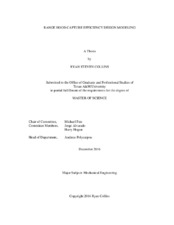| dc.description.abstract | This study assessed and modeled the performance of a range-hood ventilation system and the important aspects such as major and minor pressure losses, volumetric airflow, and capture efficiency. Results can be classified into two parts: previous test data and the EES program model. Previous test data include fan performance curves produced by the Riverside Energy Efficiency Laboratory (REEL), vent cap performance data produced by a former student at the REEL facility and capture efficiency data published by Lawrence Berkeley National Laboratory (LBNL). An assortment of six (6) fans, twenty-two (22) vent caps, and the capture efficiency equations were used to complete a mathematical model in the EES program.
The vent cap performance data collected was for the two most common residential ventilation duct diameters, 4-inch and 6-inch in the variety of wall-mounted, roof-jack, and soffit. With most range-hoods using the larger duct size, all fan performance curves collected were 6-inch round. Trend lines using a spreadsheet calculator were constructed to fit the associated static pressure and flow rate data plots. It was shown that increasing the R^2 value to a maximum of one (1) did not necessarily produce trend lines similar to the experimental data. In fact, a third degree polynomial trend line in most cases fit the experimental data better than a larger degree polynomial. Graphing alongside the experimental data was determined to be the best way to quickly see how well the trend line fit the experimental data.
With the combination of fan and vent cap performance, associated ductwork, and the capture efficiency data from LBNL, a mathematical model was constructed and implemented in the Engineering Equation Solver (EES) software. Careful use of trend lines and initial variable guesses allowed the EES program to converge to a solution. Being dependent on airflow, capture efficiency range was from 49% - 94%. | en |


